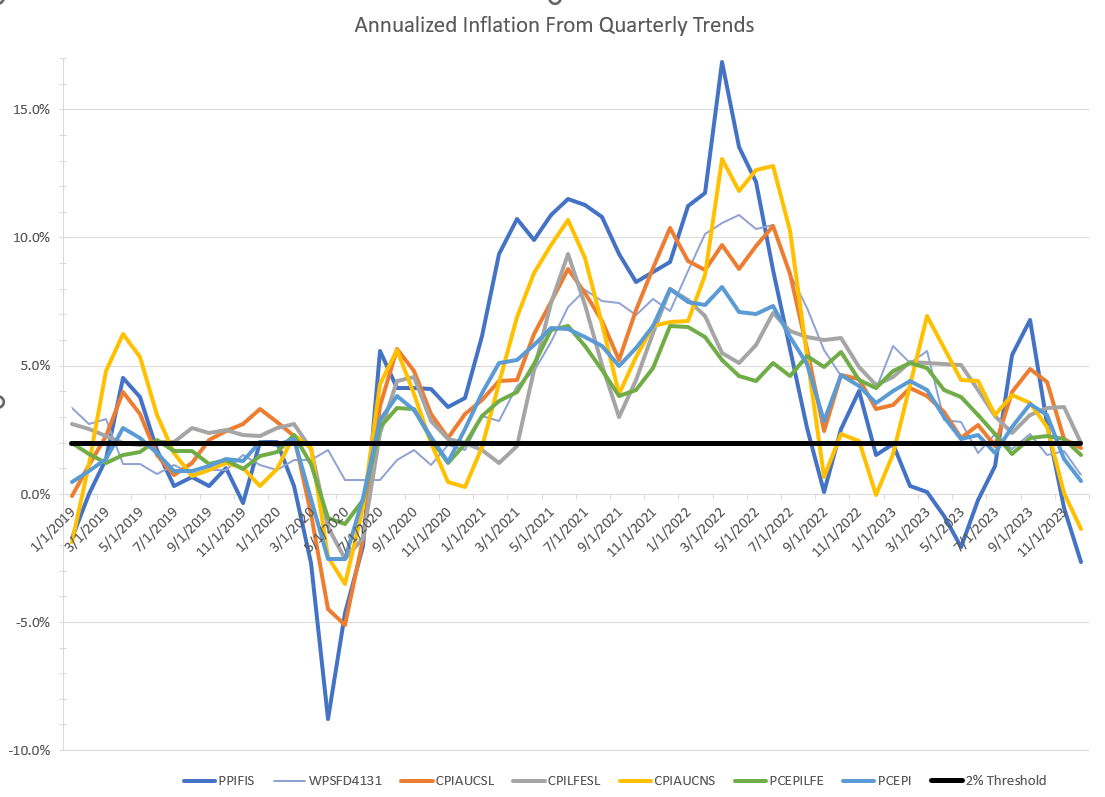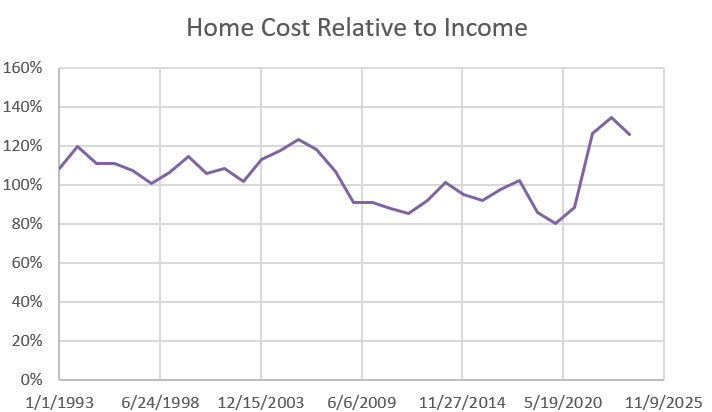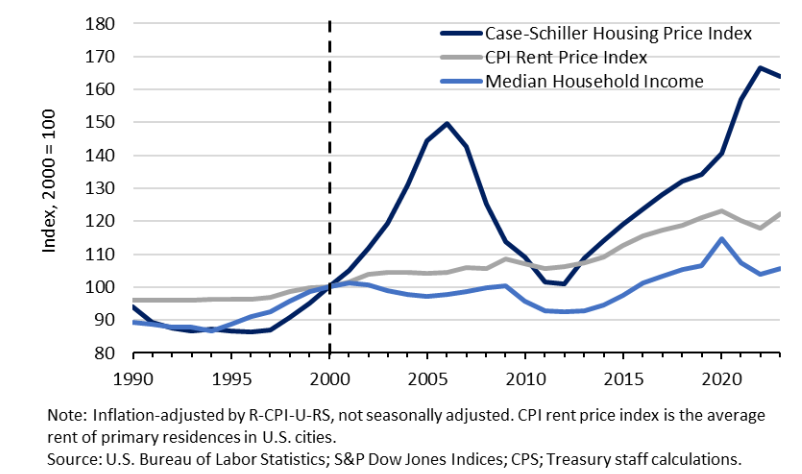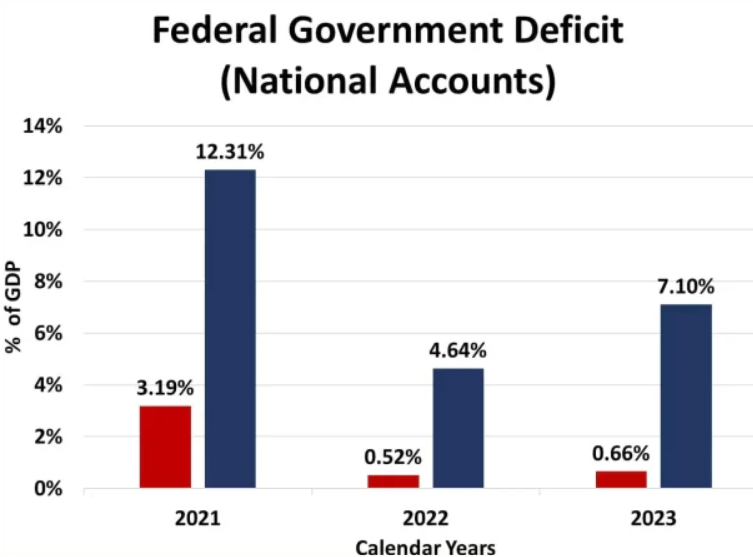Colin Read • January 26, 2024
Month-end Economic Roundup - Sunday, January 28, 2024

Regular readers are familiar with the month-end summary of macroeconomic events. While the markets are finally coming around to what we’ve been observing for the last six months, it is nonetheless gratifying to see inflation stability returning. Our observations also have implications on Federal Reserve policy, perhaps as early as March, but maybe a bit more likely mid-year.
The issue has been inflation. It has been well-documented in this blog that prices began to increase relatively early in the COVID era as supply was constrained due to stay-at-home policies. At the same time, demand was enhanced because of large checks sent to most households under the Trump and early Biden regimes.
These supply chain constraints, exacerbated by excessive fiscal stimulus, resulted in the largest inflation since the 1979 stagflation. In that stagflation, a supply shock related to rapidly rising oil prices were perpetuated even once these prices stabilized. Western economies had shot themselves in the foot by becoming too dependent on OPEC oil, and hence had little opportunity to substitute away from petroleum, even as then-president Carter symbolically mounted solar panels on the White House roof.
The roots of that inflation began fifty years ago, but their effects lasted eight years, and still reverberate in monetary policy circles today. Then we recognized that it is easy to shoot our economy in the other foot if we don’t acknowledge and incorporate permanent structural changes in the supply chain.
Then, we allowed wages to rise to indemnify households from the increase in energy costs. That policy is akin to printing more money if a nation runs a perennial budget deficit. The policy merely papers over a larger problem and delays fixing the economic dysfunction.
The problem then was that a greater share of spending and wealth went to OPEC nations. This necessarily made Western consumers poorer. To try to fix this by raising wages was just the dog chasing its tail. But, the problem with wage growth to fix an unrelated problem means that a small economic disturbance becomes a large one.
History repeats itself. This time, the supply shock was COVID. The dysfunctional policies began first with COVID dividend checks sent to households, and to some businesses that did not need the support. All this sudden money, but with nothing available to buy, meant both prices rose and checking accounts increased. This bubble also translated into higher stock prices as people sought returns over the paltry interest earned in bank accounts until recently.
The structural change was that people used this output lull to exit from the traditional labor force, through the gig economy and through accelerated retirement plans. We still see this phenomenon. The unemployment rate continues to be very low, and shall remain so as these next four years will result in the largest wave of baby boomer retirement we’ve ever seen.
At the same time, high school graduation will plummet as the cohort missing when people stopped having babies following the Great Recession of 2008 finally reach the workforce and college age of 18 over the next few years. To gauge how profound demography can be, we only need to look at the thirty years of stagnation Japan has suffered when it went through major demographic changes in the 1990s.
These major, almost unprecedented structural changes in the labor force add additional pressure to wages and hence prices. The Federal Reserve was not on top of all this a couple of years ago but finally saw the perfect storm a little more than a year ago. They rose interest rates at a rate not before seen, and slowed demand for new construction, homes, and unnecessary debt-driven spending. It worked.
In fact, the economy went through a brief recession according to the traditional measure of two quarters of economic transaction. But, the National Bureau of Economic Research, the umpire of recessions, was unwilling to use the R word when the unemployment rate remained stubbornly low.
So, the belated Fed policy worked, The economy slowed as spending declined. Inflation abated, even though prices will never return to where we were, and wage increases failed to keep up. We are (most) all a little poorer, except those who don’t need to spend much of what they earn. But, GDP growth has been very robust, at 4.9% annualized in the third quarter, and an estimated 3.3% in the 4th. The question is then what will the Fed do next?
The Fed looks most closely at one measure of inflation, the increase in spending according the the Personal Expenditure Survey. It also watches the consumer price index and the producer price index. Each of these measures of prices are also calculated by omitting their most volatile major elements, food and energy. We then have half a dozen measures that track prices and compare the level of prices now to a year ago.
What is magical about a year? Beyond any minor seasonal variations that are neutralized if we compare a month to the same month a year ago, there is nothing magical about annual inflation. We could instead focus on month-to-month inflation, and then multiply that inflation by 12 (roughly) to get an annualized measure. The disadvantage of M-to-M price changes is that unusual events can give rise to a distorted measure.
More meaningful is to look at the annualized inflation rate from more recent price changes, over six or three months. These measures provide us with a much better sense of what is happening now, not a year ago.
As you know, I calculate the six and three month inflation rates, all annualized for easy comparison. Today’s graph shows the quarter-to-quarter inflation trend, but the six month price changes are comparable. Either measure, over the six different indices the Fed looks at, all show an inflation rate of less than 2%. The Fed’s work is done. But, since it still focuses on year-to-year inflation, it may not conclude its work is done for another six months yet.
At that point, it must decide whether a 6% Fed discount rate still makes sense. Even if it does not believe the economy is overheating or inflationary, it still wants a discount rate that, when adjusted for inflation, is just about right. Such a real (inflation-adjusted) interest rate has historically been around 3%-3.5%. That means the Fed can offer at least a couple of rate cuts without worrying about an inflationary rebound or about excessive economic stimulus.
By mid-year, or perhaps a little sooner if they focus on the data we present here, we should expect a minor correction in Fed policy. The adjustment won’t be large, and will certainly not have us return to the monetary dysfunction that arose from a near-zero inflation rate for the decade following the Great Recession. But, it will send out a signal to the markets that things are back to normal.
Of course, we still have not figured out what a new normal looks like. A labor force declining in size is problematic. Artificial Intelligence will change the economic landscape of who gets jobs and who do not. The federal budget deficit has increased to four-fold in barely twenty five years. Households are anxious about the economy and the growing divides among various classes in society. And populists are capitalizing on such discontent by stimulating our fears and inducing economies and nations to retrench and point fingers. And, of course, there is rapidly accelerating climate change.
All these effects are beyond the Fed’s purview or power. But, the Fed is in the job of managing economic risk, and must be prepared to act as more perfect storms brew on the horizon. Having a Federal Reserve discount rate that has room to go up and go down at least gives them a tool they have not had for some time.









